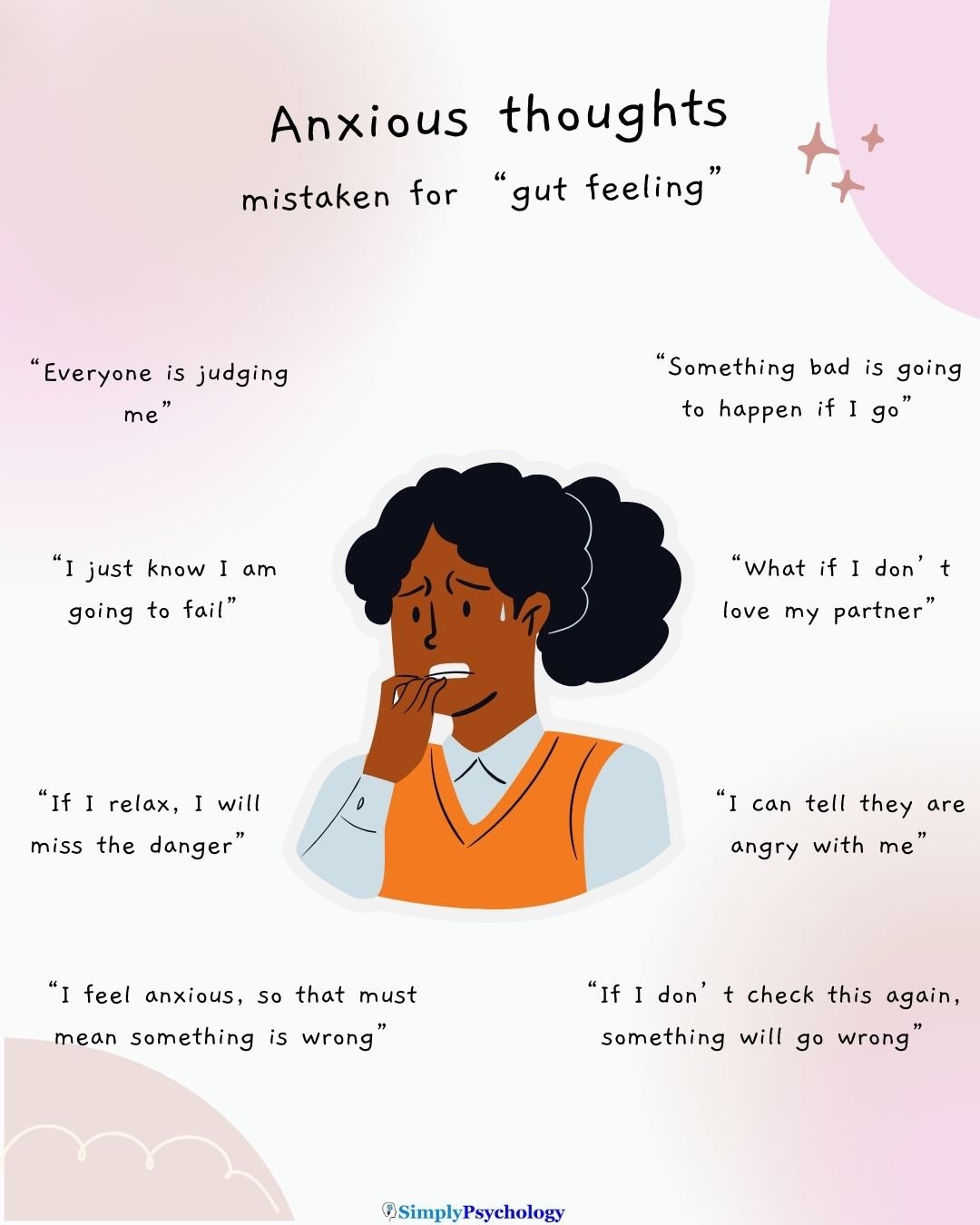Many people with anxiety find themselves second-guessing their own instincts. You might pause in the middle of a decision and wonder: “Is this my gut telling me something’s wrong, or is it just my anxiety talking?”
This uncertainty can be exhausting, leaving you unsure whether to act on a feeling or challenge it.
Gut feelings—often described as intuition—can help us make quick decisions without overthinking. Anxiety, on the other hand, tends to amplify fear and create doubt, even when there’s no real threat.
Because both can feel urgent and come with physical sensations in the body, it’s not always easy to tell them apart.
Download our free reflection sheet on this topic:
Gut Feeling Vs Anxiety Reflection Sheet
Disclaimer: This article is for informational purposes only and is not a substitute for professional mental health advice. If anxiety is interfering with your daily life, consider reaching out to a qualified professional for support.
What Is a Gut Feeling?
A gut feeling, or intuition, is the brain’s ability to deploy heuristics—mental shortcuts learned from past experiences—to make fast, unconscious judgments when we lack complete information.
It’s not mystical foresight, but a form of adaptive unconscious processing, where emotional and experiential cues guide swift decisions.
The body plays a critical role in this process through the brain–gut connection, especially via Antonio Damasio’s somatic marker hypothesis.
According to the hypothesis, emotions generate bodily signals—like a slight stomach “twinge” or racing heart—that the brain uses to steer decision-making before conscious reasoning kicks in.
In short: gut feelings are grounded in fast, unconscious reasoning—shaped by past learning and bodily feedback—not magical predictions.
What Is Anxiety?
Anxiety is an emotional response marked by worry, hypervigilance, and heightened fear about potential or uncertain future events.
It’s a natural, future‑oriented reaction—our internal alarm system—that prepares us for possible dangers by increasing alertness.
Everyday anxiety is common and typically temporary—like feeling nervous before a presentation or a new experience—but it usually subsides once the stressor passes.
In contrast, anxiety disorders involve persistent, excessive worry that doesn’t go away, affecting many areas of life and becoming difficult to control.
These disorders can distort how we perceive danger, causing us to overestimate threats or sense risk where there may be none.
Gut Feeling vs. Anxiety: Key Differences
Understanding how gut feelings differ from anxiety in everyday experience can help individuals better identify and trust their internal cues.
Duration & Intensity
- Gut Feeling: Immediate, calm, and short-lived—a sense that appears naturally in response to a specific moment or situation.
- Anxiety: Persistent, often overwhelming, and may arise even when there’s no current threat or clear trigger.
Emotional Tone
- Gut Feeling: Feels clear, centered, and usually free from inner turmoil—it’s a steady “knowing.”
- Anxiety: Emotionally charged with fear, urgency, and often dread—marked by internal chaos or tension.
Focus of Attention
- Gut Feeling: Targets a specific person, place, or situation in the present moment—clear and direct.
- Anxiety: Drifts across many hypothetical scenarios, often future-oriented and scattered with “what‑ifs.”
“Intuition feels much more like a knowing, and anxiety is a questioning. I really learned about my intuition when I went against my gut… overriding it went horribly wrong…”
Physical Sensations
- Gut Feeling: Perceived as a quiet inner nudge, such as a subtle stomach cue or a soft embodied knowing, without strong distress.
- Anxiety: Accompanied by intense physical symptoms—racing heart, knots in the stomach, tension, restless energy.
“Engage in introspection and experimentation… by all means trust your gut – but only after you’ve taught yourself what’s worth trusting.”
Comparison at a Glance
| Dimension | Gut Feeling / Intuition | Anxiety |
|---|---|---|
| Duration & Intensity | Brief, calm, situation-specific | Persistent, overwhelming, often generalized |
| Emotional Tone | Neutral, clear, centered | Fearful, urgent, emotionally intense |
| Focus of Attention | Present-focused, specific cue | Scattered among many “what-if” scenarios |
| Physical Sensations | Gentle bodily knowing | Racing heart, stomach knots, tension, restlessness |
Examples of Gut Feelings
- Dating/relationships: You meet someone new and, even before they speak much, you sense they aren’t being fully honest. The feeling is calm but clear, nudging you to pay closer attention.
- Workplace decision: You’re offered a new role, and though everything looks good on paper, something inside tells you it doesn’t align with your values. The sense passes quickly but leaves a steady impression.
- Safety cue: Walking home, you suddenly feel uneasy turning down a certain street—even though you can’t explain why. The signal is sharp and specific, prompting you to choose another route.
Examples of Anxiety Misinterpreted as a Gut Feeling
- Relationship worry: You suddenly think, “My partner is going to leave me” after they don’t reply to a text right away. It feels urgent and convincing, as if your gut is warning you, but it’s really anxiety fueling fear of abandonment.
- Social anxiety: Before speaking up in a meeting, you feel a rush of dread and think, “This is my gut telling me I’ll embarrass myself.” In reality, the intrusive thought comes from fear of judgment, not a reliable signal.
- Health anxiety: You notice a minor ache and immediately think, “Something is seriously wrong.” The thought feels like a strong gut warning, but it’s anxiety amplifying normal bodily sensations into threats.
- OCD-style intrusive thought: While cooking, you suddenly think, “If I don’t recheck the stove, something terrible will happen.” It feels like intuition insisting on action, but it’s an anxiety-driven compulsion, not a genuine instinct.
“Anxiety comes from our mind. Intuition comes from our heart (or gut). Also anxiety will pass when you self-soothe… but intuition remains.”
Why Anxiety Can Feel Like Intuition
“Anxiety lies… The physical feelings of anxiety can seem like a gut feeling, but in reality, it’s often the triggered fight or flight response of anxiety.”
Anxiety can deceptively resemble intuition because both originate in deep, fast‑acting parts of the brain—and both are shaped by experience.
Trauma, chronic worry, and repeated negative experiences can sensitize neural circuits that respond to perceived threats. This means that even safe situations may trigger reactions that feel urgent or instinctual.
The amygdala, a key brain structure in threat detection, plays a central role. It responds quickly—via a low‑road pathway—to signals of danger, often before conscious thought kicks in.
In trauma‑affected brains, the amygdala can become hyper‑reactive, primed to treat benign cues as dangerous.
Essentially, anxiety hijacks our intuitive system, making panic or hypervigilance feel like a warning signal.
How to Tell the Difference in Everyday Life
Learning to distinguish between a gut feeling and anxiety in daily moments can feel challenging—especially during emotional or high-stakes situations.
Here are four practical, non-clinical strategies that can help you tune into your inner signals with clarity and compassion.
1. Pause and Notice Your Body
When a feeling arises, pause and take a few deep breaths.
Is it a fleeting nudge, or a constant, rising tension?
A true gut feeling often feels momentary—a subtle bodily cue—while anxiety tends to persist and grow.
Taking a moment to breathe can help you “get some distance” and observe what’s happening internally.
“For me intuition is a feeling that I feel deep in my stomach and all around me. It slows my heart rate and is almost like a hazy feeling. Anxiety is a feeling in my chest, speeds up my heart rate, and is more of an internal struggle than an external one.”
2. Check the Evidence
Ask yourself: Is this feeling grounded in facts, or is it fueled by “what if” scenarios?
Anxiety often thrives on hypothetical threats and worst‑case thinking, whereas a gut feeling is more tethered to present reality.
Look for supporting evidence; if it’s missing, your reaction might be anxiety-driven rather than intuitive.
3. Use Journaling or Reflection
Write down what you’re experiencing and review patterns over time.
Do these feelings repeat in similar situations—even when nothing misbehaves?
Tracking themes can reveal if you’re responding from fear.
Try journaling as a way to see things more clearly and notice patterns in your thinking.
4. Mindfulness Practices
Mindfulness helps you stay anchored in the here and now, reducing confusion between fear and intuition.
Simple exercises—like breathing techniques, body scans, or present-moment observation—can reveal whether your response feels calm (intuition) or charged (anxiety).
When Not to Listen to Your Gut
Gut feelings can sometimes be helpful, but they aren’t always accurate. They may be shaped by past trauma, stereotypes, or unchecked fear.
“When you have an anxiety disorder, ‘go with your gut’ is not always great advice, because your gut is always telling you to escape or distract… and you actually need to do the opposite of what your anxiety disorder is telling you.”
If you live with an anxiety disorder or struggle with intrusive thoughts, such as in OCD, your gut reaction may be especially unreliable—because what feels like “intuition” could actually be anxiety in disguise.
In these moments, it’s important to pause and challenge the feeling rather than accept it at face value.
Signs Your Gut Is Lying to You:
- It leads to avoidance. True intuition often nudges you toward wise action, while anxiety-driven “gut feelings” push you to withdraw or hide.
- It feels urgent and overwhelming. Intuition tends to be calm and fleeting, while anxiety comes with panic or a strong sense of “I must act now.”
- It repeats in loops. Gut feelings usually arrive once and pass quickly; anxiety keeps circling back with the same thought.
- It’s based on “what ifs.” If your feeling is tied to imagined future scenarios rather than the present, it’s likely anxiety.
- It contradicts clear evidence. If facts point one way but your “gut” insists otherwise, fear may be distorting your perception.
- It comes with intense physical discomfort. Racing heart, chest tightness, or stomach knots often signal anxiety, not intuition.
- It’s rooted in past wounds. When your “gut” reacts strongly in situations that echo past trauma or rejection, it may be a protective fear response.
“My relationship OCD sometimes had me questioning whether I truly loved my partner. I felt tricked into thinking this was my gut telling me to break up, but when I felt calmer and rationally organized my thoughts, it was easy to see that breaking up is the last thing I wanted to do.”
Challenging your gut doesn’t mean dismissing yourself—it means balancing instinct with reflection, evidence, and compassion.

